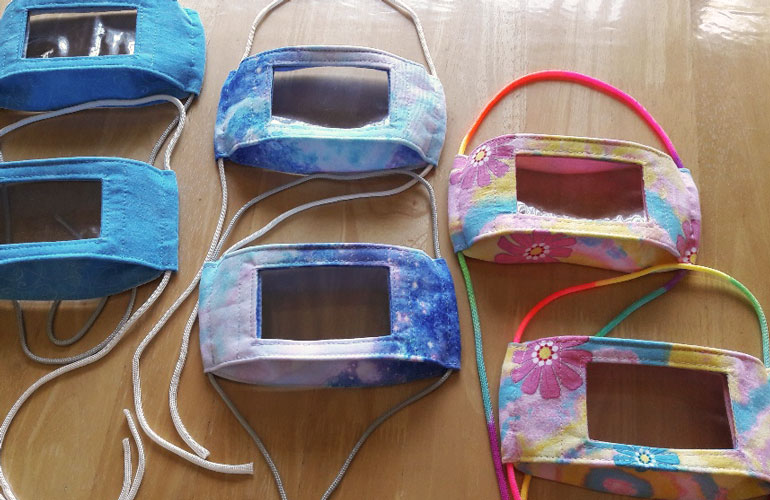Window masks
Learn about the Window Mask Project and how to create your own window masks at home.

Project overview
In 2020 while King County repair events were on hold due to Covid, the program’s sewers made reusable masks. We provided these masks to several nonprofits and institutions.
Sewers created over 1,600 reusable cloth masks and related items for Valley Medical Center (VMC) in Renton. In May 2020, the VMC Children’s Therapy Clinic began requesting window masks for speech therapy sessions. Four of our volunteer sewers truly embraced the challenge.
By December 2020, we’d distributed masks to several additional VMC clinics and other organizations. This included the nonprofit Hearing, Speech and Deaf Center, the Vashon Island Senior Center, and several King County Libraries.
The window masks proved especially useful for schools, preschools, and daycare facilities that serve children who speak more than one language. Seeing their teacher’s mouths helped small children improve their language and reading skills.
Making window masks
Window masks, also known as “smile masks,” are reusable cloth masks with a plastic panel. The clear front can help with communication, especially in settings such as speech therapy, reading and language lessons, and with people who are deaf or hard or hearing.
Watch our Window Masks 101 workshop recorded in December 2020 to learn the basics of making and using window masks. You can also listen to the audio-only version:
Watch the video:
Audio-only version:
The workshop features:
- Window mask sewers - Kathy Eytcheson, Amanda Radak, Laurie Keep, and Jessica Nash
- Valley Medical Center Children’s Therapy – Barbara Bryant
- King County EcoConsumer – Tom Watson
- American Sign Language interpreters - Pettigrew and Mary Thornton
Most of our masks were made using this free pattern by Sewing Seeds of Love.
We also recommend these patterns and tutorials:
- Accessible, Deaf-Friendly Face Mask
From the Seattle-based nonprofit Hearing, Speech & Deaf Center. - Windowed Face Mask
From Craft Passion. - Clear Face Mask with Removable Window
From HelloSewing. - Cricut Face Mask With Window
From Cricut, a Utah-based company that makes computer-controlled cutting machines for home crafters.
Tips for using window masks
Preventing fogging
Rubbing a small dab of toothpaste, shaving cream, or dish soap on the plastic panel can help prevent fogging. Make sure the mask fits properly. Ideally, the wearer’s mouth shouldn’t touch the panel.
Proper fit
Not every mask will properly fit every person. Masks should comfortably fit the wearer’s face and head size. To accommodate a range of people, mask sewers can create ones in different sizes and make them adjustable with elastic or ties.
Washing and drying
Most window masks, including ours, are made using a clear vinyl fabric. To preserve the panel, it’s best to hand wash and air dry them. Don’t use heat on the plastic panel.
Masks made using other clear plastics, such as polypropylene from a document sleeve protector, may be able to tolerate more heat.
Distributing window masks
It's important to remember that individuals who benefit from a window mask are not necessarily the one wearing the mask. The best way organizations and institutions can help is by making window masks available to staff, volunteers or others who want to use them.
If you or your organization want to provide window masks, the resources on this page can help volunteer sewers get started.

 Translate
Translate